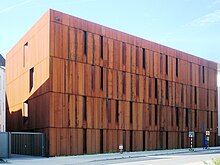Luisenschule Essen
| Luis School | |
|---|---|

|
|
| type of school | high school |
| founding | 1866 |
| closure | 2004 |
| address |
Bismarckplatz 10 |
| place | eat |
| country | North Rhine-Westphalia |
| Country | Germany |
| Coordinates | 51 ° 27 ′ 0 ″ N , 7 ° 0 ′ 24 ″ E |
| carrier | City of Essen |
The Luisenschule was a municipal high school until 2004 and one of the oldest schools in the city of Essen . Today part of the Burggymnasium and the Essen city archive are housed in the building.
history
The Luisenschule was founded in 1866 as the First Higher School for Daughters in Essen . From 1903, the school building was built on Bismarckplatz according to designs by the Stuttgart Art Nouveau architect F. Paulsen and moved into in 1906. The girls' school was named Luisenschule in 1912, with the Prussian Queen Luise giving it its name.
During the Second World War , the Luisenschule, along with several other Essen schools, became a camp for forced laborers. From 1943 up to 750 Eastern European workers were housed in the 25 classrooms. They mostly served the city to clear rubble. Before large parts of the school were destroyed by bombs in 1945, the Secret State Police (Gestapo) had used part of the building as a prison camp for foreign workers. After the war, the school was rebuilt in a simplified manner.
Boys started school in the early 1970s. The final closure took place in 2004.
Until then, it had been offering a bilingual French branch since 1982 , in which pupils were in the sixth, ninth and eleventh grades in exchange programs with the schools College International de Fontainebleau near Paris (grade 6) and Montlouis sur Loire near Tours (Grade 9) participated. There were also exchange programs with the schools "Collège du Cèdre" in Le Vésinet near Paris and "Lycée Sainte-Agnès" in Angers. In the twelfth stage, internships in other French countries were possible.
There were also regular exchanges in other countries. In the eighth level it was possible to take part in an exchange with the English partner school Rainham Mark Grammar School . An annual exchange with the Oscarsgymnasiets in Oskarshamn (southern Sweden ) was organized for the upper school students .
In 1988 the school building was placed under monument protection.
Todays use
Today, part of the former school building is used as a branch of the Burggymnasium in Essen , where the secondary level II is housed. The Erich Brost Vocational College also uses some of the rooms in the building on the second floor.
The Haus der Essener Geschichte / Stadtarchiv is located on two of the four floors of the original school building . The last restoration of the old school building took place in 2007 as part of the construction of a new warehouse for the city archive with a striking COR-TEN steel facade that structurally closes the gap in the school block that was created during the war.
literature
- Monika Josten, Brigitte Sternberg: “Time is iron and fate is tremendous.” Two Essen schools in World War I. In: The First World War . Rhine-Maas History, Language and Culture Vol. 5 (2014), Institute for Lower Rhine Cultural History and Regional Development (Ed.), Pp. 158–167.
- The youth is sacred . Festschrift for the 60th anniversary of the Luisenschule Essen, Oberlyzeum and Frauenschule 1866–1926. Essen 1926.
- 125 years of the Luisenschule 1866–1991 . Festschrift, Essen 1991.
Web links
Individual evidence
- ↑ Memorial plaques on the object
- ↑ Luisenschule in the list of monuments of the city of Essen (PDF; 538 KiB); accessed on October 8, 2016


